





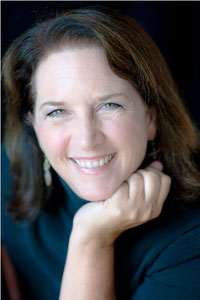
Debra Prinzing Photo: Mary Grace Long
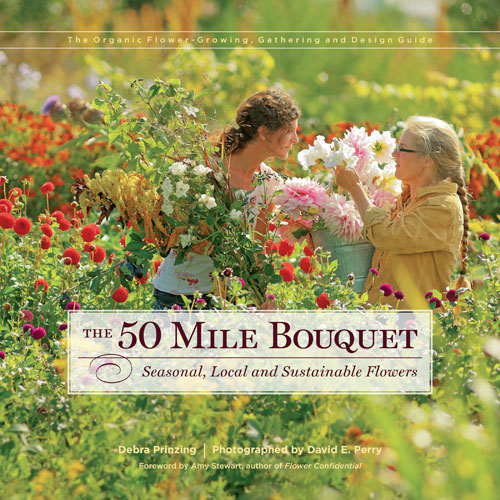
Debra Prinzing is a Seattle- and Los Angeles-based outdoor living expert who writes and lectures on gardens and home design. She has a background in textiles, journalism, landscape design and horticulture. She speaks frequently at botanical gardens, horticultural societies and flower shows. She is also a regular radio and television guest. Her most recent book is the The 50 Mile Bouquet: Local, Seasonal and Sustainable Flowers (St. Lynn's Press, April 2012), which was photographed by David Perry. Her other books include Stylish Sheds and Elegant Hideaways (Clarkson-Potter/Random House, 2008), a Garden Writers Association Gold Award book, and The Abundant Garden (2005).
Debra is a contributing garden editor for Better Homes & Gardens and her feature stories on architecture and design appear regularly in The Los Angeles Times' Home section. She is also a contributing editor to Garden Design magazine and writes for top shelter and consumer publications, including Organic Gardening, Horticulture, Fine Gardening, Cottages & Bungalows, Metropolitan Home, Landscape Architecture, Sunset, Alaska Airlines Magazine, Old House Interiors, Seattle Homes & Lifestyles and Romantic Homes.
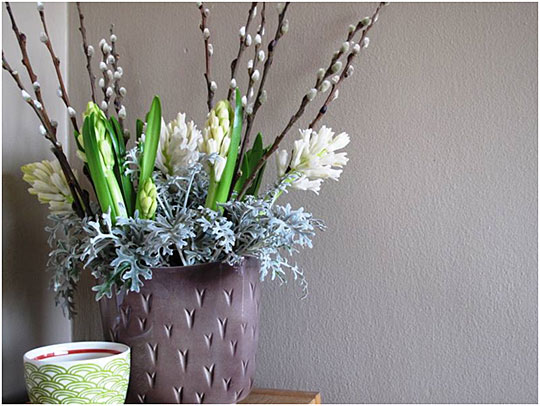
Hyacinths, pussy willow branches and dusty miller leaves. Photos: Debra Prinzing
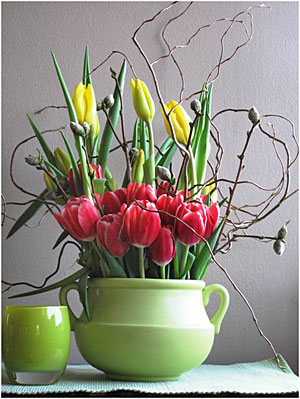
Tulips, willow, and camellia branches.
As you plan your own cutting garden, consider these favorites for 2012, named by members of the Association of Specialty Cut Flower Growers:
For more ideas, check out the Cut Flowers of the Year from prior years.
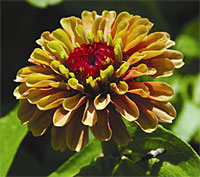
Queen Red Lime zinnia. Photos courtesy of ASCFG
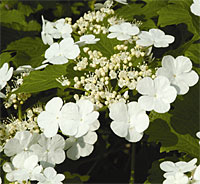
Wentworth viburnum
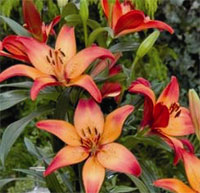
Royal Sunset lily
I started my sweet pea seeds two weeks ago and now their brilliant green seedlings are several inches tall and ready to move from my seedstarting area in the garage out into the garden.
Greedy for fragrance, romance and color, I may have gone overboard. I chose about a dozen varieties of sweet peas. I'll plant them around the perimeter of my patio, where a beautiful white pergola serves as a trellis.
I will stretch vertical rows of twine for the tendrils to cling to, but I'll also set up Expandable Black Bamboo Trellises. These will work perfectly as vertical supports, suspended from the pergola's top beams.
Next week I'll sow new flats of flower seeds indoors or direct-sow them outside, depending on the weather. My list includes nasturtiums, amaranths, cosmos, sunflowers, nicotiana and zinnias. By planting something new every week or so — beginning after the threat of frost has passed — the garden will produce bouquets and bouquets of blooms all season long. There's a reason many of the most beloved favorites are called cut-and-come-again flowers. Clipping flowers makes many plants, especially annuals, produce even more blooms.
For the past several years, gardeners have been focused on the vegetable garden. But lately, it seems like people are rediscovering the cutting garden. Thank goodness! In my new landscape, which I inherited when we moved to Seattle's historic Seward Park neighborhood, I plan to rip out a mish-mash of groundcovers, perennials and herbs to make way for a hard-working cutting garden. My friend Kelly Sullivan of Botanique Flowers, a Seattle garden and floral designer, is coming over to help me map out the cutting garden. I need her help with a well-organized scheme that is both attractive and ensures lots of blooms.
It turns out that I'm not the only gardener eager for more flowers in my vase. Earlier this year, in the London Telegraph, Sarah Raven quoted Mr. Fothergill's Seeds as predicting cut flower seeds to be the big growth area in the next three years. "It has seen sales increases of around 15 percent in the past 18 months in all cut flowers species," she wrote.
"The British Isles and Europe tend to be five years (or more) ahead of the USA in trends," says Ed Hume of Seattle-based Hume Seeds. So, he hasn't yet seen the explosion of flower-seed sales. That observation was echoed in a recent New York Times article by Michael Tortorello, who wrote: "At the same time flower (seed) purchases fell, food-garden spending climbed 20 percent," he wrote.
Yet, after spending the past few years interviewing domestic flower farmers who use sustainable practices to grow seasonal crops, and eco-conscious florists who are sourcing their design ingredients from local fields, I am convinced that the pendulum is beginning to swing back to cutting gardens.
Even if food gardeners aren't obsessed with filling their vases like I am, their edible crops will benefit from the presence of pollinators. And what attracts pollinators but nectar sources: annuals, perennials and other flowering plants.
Copyright © www.100flowers.win Botanic Garden All Rights Reserved